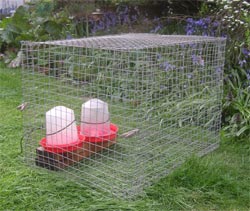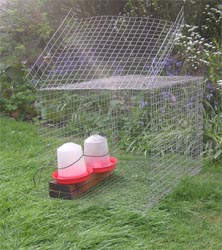How to make a broody coop to stop your chickens and bantams being broody (takes 1 hour to make)
Posted by Fiona Nevile in Chickens | 130 comments “Two of my hens are broody.” Bunty was exasperated.
“Two of my hens are broody.” Bunty was exasperated.
“We’ve got a broody one too.”
This was our first summer of keeping bantams (a small friendly breed of chicken).
Bunty continued, “I wish I hadn’t suggested Bantams. I’ve discovered that they go broody at the drop of a hat.”
Years ago Bunty had kept chickens commercially. Those were a type of chicken bred for laying that rarely go broody.
She thought that she had the answer to our dilemna.
“We need anti broody coops. You’re good at making things. Why don’t you make a couple?”
My heart sank. I thought that they would take hours to make, imagining a sort of dog kennel with a wide gauge wire mesh floor.
To stop a hen being broody you need to stop her from settling comfortably. The trick is to construct a cage with a floor made of large wire mesh ( with at least 1 inches squares). Set the cage on bricks so that the floor is suspended, keeping the bricks to the outside edges so that she can’t sit on them. Provide a small drinking fountain and feeder within the cage and pop her in. She won’t be able to settle on the wire mesh floor and within a few days will get over her broodiness.
I went to bed early and woke at four. In the still cold light I realised that the entire cage could be made of wire mesh. I went to the garden centre after breakfast and bought three sheets of wire mesh measuring 90cm x 60cm. The cage is 60 cm long and 43 cm high and 43 cm wide This allows for an overlap at the joins.
Our broody coop is simple to make. Lay the wire on a flat surface, and bend 2 cm of wire mesh to a 90 degree angle along a 60 cm side. Then lift the opposite end and press it into the angled flap. Press firmly on the bulgy end and fold flat to make a clean angle and pull the ends apart. You now have the floor and one side. Repeat the operation for the roof and the other side.The flap may seem a bit fiddly but it makes the cage much more rigid and stable.
Now attach the the two halves together to make the body of the cage. I tied the two together with twists of wire at 5cm intervals. The front and back of the cage are made from the remaining sheet. Hold the sheet against the opening at the back and cut to fit using wire clippers. The back was attached using wire twists. The front is hinged at the top with sides that bend back a bit over the sides of the cage.
Having a hinge at the top makes it easier to put the chicken in the cage. If you put her in headfirst you can quickly drop the door down and secure it with pegs before she has turned around. We used clothes pegs but small bulldog clips would be good for a larger chicken.

The broody coop in the photo is the mark one version. I made Bunty a Rolls Royce (mark two) cage out of plastic coated wire. Definitely worth the extra investment as it’s stronger and more durable. Carol (our Maran) has never been broody. If she was, I’d make her a bigger cage (the hen needs to be able to stand up). And it would have to be stronger than the mark one cage as she is a much larger bird than the bantams.
Our broody coop sits in the Day Centre. Bunty had hers in the run with a bit of wood as a roof.
It took me a while to realise when the perfect moment of release should take place. The chicken in the broody coop will ask to be released immediately. But bide your time. Her comb will gradually change from pink to red. When it is red she can get out of jail. If you release her while her comb is still pink she will nip back to the nesting box and you will have to start the process all over again.
If you have a broody chicken and you want her to sit on fertilised eggs put a floor on the bottom of the broody coop, fold the door over the roof and you have a quiet area in which she can sit for twenty one days, with easy access to food and water. She needs to be able to move away from the nest so don’t lock her in. Ideally, place the cage somewhere that is protected from the elements. Or construct a simple roof like Bunty did (a bit of plywood slightly bigger than the cage). It’s not a good idea to let a broody hen stay in the nesting box as it puts the other hens off laying eggs.
Leave a reply





how long does it take for a cornish cross to mature
Hi Misti,
The black skin is a problem. I think that you will have to leave them in the anti broody coups for a few days (generally three days does the trick)before releasing them. If they are still broody, they shoot straight up to the nesting boxes. If they do this put them back in the cages immediately for a few more days. It has to be trial and error with your silkies.
Broody chickens in the nesting boxes seem to put the other chickens off lay. It could also be the time of year, our egg production drops off in the autumn.
Thank you so much for the ideas and information! We raise silkies and when they are laying the eggs are great – but then they decide they want to be mamas (again!), I have three hens on empty nests right now and can’t get them off for more than a few moments once or twice a day. My husband will be building those broody coops this weekend! My question is this; silkies have black skin, how do I know when they are ready to be let out? I didn’t know not to leave them in the nest boxes – is that why the rest of the hens seem to have stopped laying? I will appreciate any help that you can give me!
Hi Anthony,
So pleased that our info helped. Hop that she switches back soon. Thanks for leaving a comment.
Many Thanks, for the information, Ive just popped our Bantam in and will be watching her with a close eye for the colour change.
I know what you mean. I have to get in and out of our run ultra fast so as not to let chickens out or baying Min Pins in.
Once Carol escaped. Chicken and dogs were so shocked that nothing happened and she shot back in again.
Great idea, thanks for sharing! I wish we had room for some hens (I never totally trust ‘Organic’ Eggs from the supermarket) but our garden is the size of a postage stamp AND our dogs love the taste of chicken unfortunately!
Hello Ash,
My Aunt kept a lot of bantams in a meadow where she lived. The raised them for eggs and meat.
She started keeping chickens when she was four and throughout her life until she died at the age of eighty three. I had no interest in chickens at the time which is a shame as seventy nine years of experience would have been handy.
Hi Angelfeet,
I didn™t know much about chickens until we started keeping them.
A broody hen is a hen who has the urge to hatch a brood of chicks and will therefore sit on the nest over any eggs (fertilised or unfertilised) as part of the hatching instinct. When a hen is broody, she stops laying eggs. So if you want her to lay eggs you have to encourage her out of her broodiness.
We have a post Mrs Boss is Broody https://www.cottagesmallholder.com/?p=25
which gives a bit more information about broody hens. The broody season is just starting in England.
Incidentally you can put fertilised eggs under a hen and she will think that the chicks are her own, even if they are ducklings, pheasant, quail. You can also swap the eggs between chickens. Carol (our large Maran hen was reared by a bantam). This is described here
https://www.cottagesmallholder.com/?p=194
Mrs Boss is in fact broody at the moment and she will be going into the broody coup this evening.
I hereby display my complete ignorance. What is a broody hen and why is it something to be avoided (although that second part of the answer may be obvious once you’ve answered part one!)
I remember my gran complaining about the chickens being broody all the time! I didn’t know about the combs, thanks for the education.